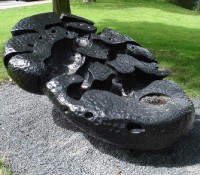4:15 AM -  Space Facts
Space Facts
 No comments
No comments
 Space Facts
Space Facts
 No comments
No comments
Meteoroid Facts
 Meteoroid Facts
Meteoroid FactsEnjoy these great meteoroid, meteor and meteorite facts for kids. Learn the differences between the terms used to describe them, how fast they travel, how often they make it through Earth’s atmosphere and much more.
- A meteoroid is a small rock or particle of debris in our solar system. They range in size from dust to around 10 metres in diameter (larger objects are usually referred to as asteroids).
- A meteoroid that burns up as it passes through the Earth’s atmosphere is known as a meteor. If you’ve ever looked up at the sky at night and seen a streak of light or ‘shooting star’ what you are actually seeing is a meteor.
- A meteoroid that survives falling through the Earth’s atmosphere and colliding with the Earth’s surface is known as a meteorite.
- The fastest meteoroids travel through the solar system at a speed of around 42 kilometres per second (26 miles per second).
- The Earth’s atmosphere experiences millions of meteors every day.
- Meteors are easier to see during the lower light conditions of night.
- A small percentage of meteoroids fly on a path that goes into the Earth’s atmosphere and then back out again, they are known as Earth grazing fireballs.
- When many meteors occur in a close time frame in the same part of the sky it is called a meteor shower.
- Around 500 meteorites reach the Earth’s surface every year but of those only around 5 ever make it to scientists for study.
- Meteorites that are observed as they fall through the Earth’s atmosphere and later recovered are called ‘falls’, all others are called ‘finds’. To this date there have been around 1000 collected ‘falls’ and 40000 ‘finds’.
- Unsure why a meteoroid is different to meteor, comet or asteroid? Learn the difference between a comet, asteroid, meteoroid, meteor & meteorite.
0 comments:
Post a Comment